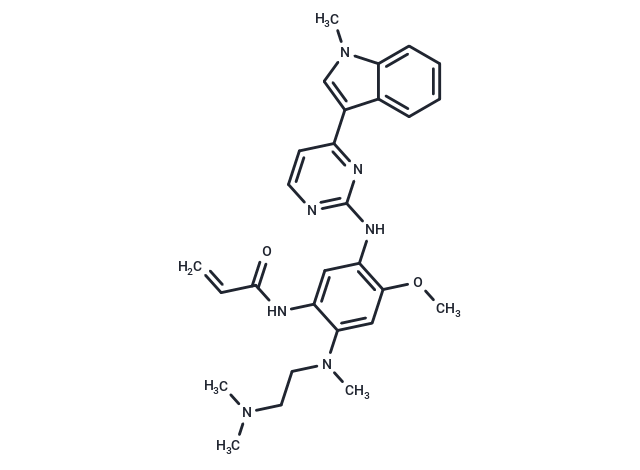Shopping Cart
Remove All Your shopping cart is currently empty
Your shopping cart is currently empty
Osimertinib (AZD-9291) is an EGFR third-generation inhibitor that inhibits the T790M resistance mutation produced by second-generation EGFR inhibitors with irreversible and oral activity. Osimertinib has antitumor activity for the treatment of EGFR-mutated non-small-cell lung cancer.

| Pack Size | Price | USA Warehouse | Global Warehouse | Quantity |
|---|---|---|---|---|
| 2 mg | $30 | In Stock | In Stock | |
| 5 mg | $46 | In Stock | In Stock | |
| 10 mg | $53 | In Stock | In Stock | |
| 25 mg | $65 | In Stock | In Stock | |
| 50 mg | $77 | In Stock | In Stock | |
| 100 mg | $100 | In Stock | In Stock | |
| 500 mg | $123 | In Stock | In Stock | |
| 1 g | $148 | In Stock | In Stock | |
| 2 g | $218 | In Stock | In Stock | |
| 5 g | $365 | - | In Stock | |
| 1 mL x 10 mM (in DMSO) | $46 | In Stock | In Stock |
| Description | Osimertinib (AZD-9291) is an EGFR third-generation inhibitor that inhibits the T790M resistance mutation produced by second-generation EGFR inhibitors with irreversible and oral activity. Osimertinib has antitumor activity for the treatment of EGFR-mutated non-small-cell lung cancer. |
| Targets&IC50 | MNK2:48.6 nM, MNK1:324 nM, H1975 cells:1.78 μM, EGFR (WT):493.8 nM, EGFR (exon 19 deletion):12.92 nM, PC9 cells:0.66 μM, EGFR (L858R/T790M):11.44 nM |
| In vitro | In the EGFRm+ (PC9) and EGFRm+/T790M (H1975) tumor models, oral administration of AZD9291 (5 mg/kg) effectively inhibits AKT and ERK signaling pathways as well as EGFR phosphorylation in tumors, leading to tumor regression. |
| In vivo | In mutant EGFR cell lines, AZD9291 effectively inhibits cell proliferation. |
| Kinase Assay | ACY-1215 is dissolved and subsequently diluted in assay buffer [50 mM HEPES, pH 7.4, 100 mM KCl, 0.001% Tween-20, 0.05% BSA, and 20 μM tris(2-carboxyethyl)phosphine] to 6-fold the final concentration. HDAC enzymes are diluted to 1.5-fold of the final concentration in assay buffer and pre-incubated with ACY-1215 for 10 minutes before the addition of the substrate. The amount of FTS (HDAC1, HDAC2, HDAC3, and HDAC6) or MAZ-1675 (HDAC4, HDAC5, HDAC7, HDAC8, and HDAC9) used for each enzyme is equal to the Michaelis constant (Km), as determined by a titration curve. FTS or MAZ-1675 is diluted in assay buffer to 6-fold the final concentration with 0.3 μM sequencing grade trypsin. The substrate/trypsin mix is added to the enzyme/compound mix and the plate is shaken for 60 seconds and then placed into a SpectraMax M5 microtiter plate reader. The enzymatic reaction is monitored for release of 7-amino-4-methoxy-coumarin over 30 minutes, after deacetylation of the lysine side chain in the peptide substrate, and the linear rate of the reaction is calculated[1]. |
| Cell Research | AZD-9291 is dissolved in DMSO and stored, and then diluted with appropriate medium before use[1]. PC-9 cells are seeded into T75 flasks (5×105 cells/flask) in RPMI growth media and incubated at 37°C, 5% CO2. The following day the media is replaced with media supplemented with a concentration of EGFR inhibitor equal to the EC50 concentration predetermined in PC-9 cells. Media changes are carried out every 2-3 days and resistant clones allowed to grow to 80% confluency prior to the cells being trypsinised and reseeded at the original seeding density in media containing twice the concentration of EGFR inhibitor. Dose escalations are continued until a final concentration of 1.5 μM Gefitinib, 1.5 μM Afatinib, 1.5 μM WZ4002 or 160 nM AZD-9291 are achieved[1]. |
| Synonyms | Mereletinib, AZD-9291 |
| Molecular Weight | 499.61 |
| Formula | C28H33N7O2 |
| Cas No. | 1421373-65-0 |
| Smiles | CN1C=C(C=2C1=CC=CC2)C3=NC(NC4=C(OC)C=C(N(CCN(C)C)C)C(NC(C=C)=O)=C4)=NC=C3 |
| Relative Density. | 1.19 g/cm3 (Predicted) |
| Storage | Powder: -20°C for 3 years | In solvent: -80°C for 1 year | Shipping with blue ice/Shipping at ambient temperature. | ||||||||||||||||||||||||||||||||||||||||
| Solubility Information | Ethanol: 22 mg/mL (44.03 mM), Sonication is recommended. DMSO: 120 mg/mL (240.19 mM), Sonication is recommended. H2O: < 1 mg/mL (insoluble or slightly soluble) | ||||||||||||||||||||||||||||||||||||||||
| In Vivo Formulation | 10% DMSO+40% PEG300+5% Tween 80+45% Saline: 9.2 mg/mL (18.41 mM), Suspension. Please add the solvents sequentially, clarifying the solution as much as possible before adding the next one. Dissolve by heating and/or sonication if necessary. Working solution is recommended to be prepared and used immediately. The formulation provided above is for reference purposes only. In vivo formulations may vary and should be modified based on specific experimental conditions. | ||||||||||||||||||||||||||||||||||||||||
Solution Preparation Table | |||||||||||||||||||||||||||||||||||||||||
Ethanol/DMSO
DMSO
| |||||||||||||||||||||||||||||||||||||||||
| Size | Quantity | Unit Price | Amount | Operation |
|---|

Copyright © 2015-2026 TargetMol Chemicals Inc. All Rights Reserved.